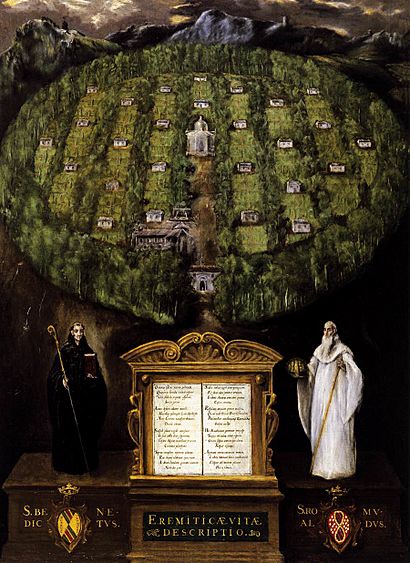Allegory of the Camaldolese Order facts for kids
Quick facts for kids Allegory of the Camaldolese Order |
|
|---|---|
| Spanish: Alegoría de la Orden de los Camaldulenses | |
 |
|
| Artist | El Greco |
| Year | ca. 1600 |
| Medium | oil on canvas |
| Dimensions | 124 x 90 cm (48.8 x 35.4 in) |
| Location | Instituto Valencia of Don Juan, Madrid, Spain |
The Allegory of the Camaldolese Order is a famous painting created by the artist El Greco and his team around the year 1600. There are two versions of this painting. One is kept at the Instituto Valencia of Don Juan in Madrid, and the other is at the Museo del Patriarca in Valencia, both in Spain.
These paintings show a "bird's-eye view" of what the Camaldolese monks thought an "ideal monastery" should look like. An allegory is a picture that tells a story or shows an idea using symbols. This painting was probably ordered to help Fray Juan de Castañiza, a monk, in his request to King Philip II in 1597. He wanted to start the Camaldolese monastic order in Spain.
Who Paid for the Paintings?
The painting in Madrid has a coat of arms on it. A coat of arms is like a family symbol. This one belongs to Mariana de Mendoza of Toledo and her husband, Pedro Lasso de la Vega. They were wealthy people who owned many paintings by El Greco.
The Allegory of the Camaldolese was likely the only painting they specifically asked El Greco to create. This shows how much they supported Fray Juan de Castañiza's plan and how much they liked El Greco's art.
It's not known for sure who ordered the painting now in Valencia. However, it has the coat of arms of Juan de Ribera, who was an important religious leader. Some art experts think that Mariana and Pedro Lasso might have given this painting as a gift to Juan de Ribera, instead of him ordering it himself.
See also
 In Spanish: Alegoría de la orden de la Camáldula (El Greco) para niños
In Spanish: Alegoría de la orden de la Camáldula (El Greco) para niños
- List of works by El Greco

